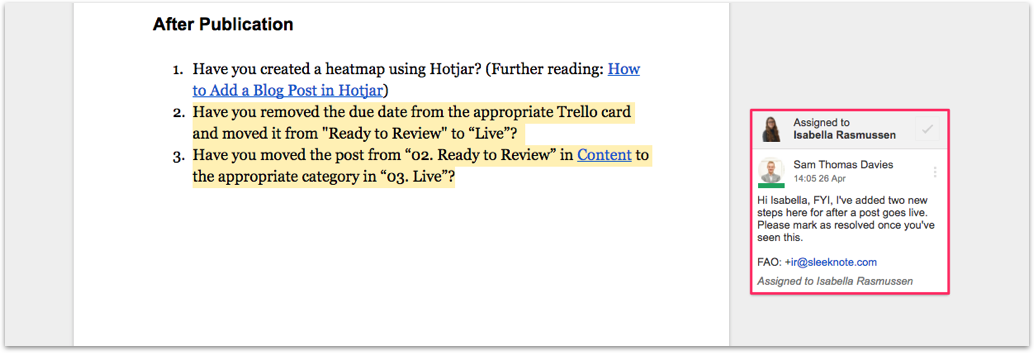You’re a smart, savvy business owner running and growing a profitable online business. You have a reliable team of employees who are as passionate as you are about going to work and a work culture that breeds positivity. When you’re available, your business runs like a well-oiled machine. Your employees know what’s expected of them and perform at a standard you worked diligently to instill.
But when you’re away...
It’s never the quite the same. Invoices aren’t filed correctly, client requests aren’t completed, and orders don’t arrive on time.
Let’s be clear: The problem isn’t your employees. As mentioned, they’re as equally committed to achieving your company’s goal as you.
The problem is you don’t have systems in place—documented Standard Operating Procedures (SOPs) that outline exactly what to do, and when and how to do it. And without them, you’re unlikely to scale your company in a predictable and repeatable way.
In this post, you'll learn how to systemize your business using Google Docs while increasing employee efficiency in the process.
Step 1: Make a list of your most recurring tasks
Before you dive in to your business systemization, take a step back to look at all your daily and weekly tasks and obligations.
Here’s how to do that: First, create a new Google Doc and write down every activity or effort you’re responsible for. Then, write how long it takes to complete each task (if you don’t know, estimate for now).
Next, organize your list by duration (e.g. 30-minutes, 60-minutes, etc.).
Finally, go through each point and ask yourself, "Can I delegate this task?"
If, for example, content marketing is an integral part of your marketing strategy and you’re responsible for writing content, you might write down: research blog posts, write blog posts, upload blog posts to Wordpress, and more.
In doing so, you might realize, though important, uploading a blog post to Wordpress isn’t a productive use of your time, and therefore can be handed over to another colleague.
Once you have a list of tasks you can delegate, you’re ready for step two.
Step 2: Decide on a directory structure
Ideally, before documenting each of your processes, you need a well-organized hierarchy of folders in Google Drive.
Doing so allows each employee to know where to look if they’re ever unsure how to perform a task.
While organization is a matter of preference, a good rule of thumb is to organize by department.
If we return to our previous example of documenting how to publish a blog post, your folder hierarchy might look like this:
Take Keap's Lifecycle Automation Assessment to identify growth opportunities for your business.
Step 3: Document your processes
Once you’ve identified which tasks you can delegate and you’ve chosen an organizational hierarchy, you’re ready to begin documenting your methods.
This is arguably the most time-consuming part of the process, but it’s relative compared to how much time you’ll save in the future when onboarding new employees.
Like before, create a new Google Doc and outline how the given task is completed, step-by-step, in as much detail as possible.
The curse of knowledge prevents us from remembering what it was like to be a beginner, so it’s crucial you put yourself in the shoes of someone who’s never performed the task before.
With each step, include a screenshot using a tool like Awesome Screenshot, and if need be, annotated to highlight key areas of importance.
Here’s an example of “How to Publish a Blog Post in Wordpress”:
You’ll notice each action has a step of its own and is explained in simple, concrete terms. Nothing is left ambiguous and most importantly, any anyone can follow it to complete the task.
Step 4: Ask a colleague to perform a task
Once you have documented a process, it’s time to test its effectiveness.
If you’re delegating the task (rather than automating it), ask the person who will be performing the task to go through it.
Here’s the important part:
If they have any questions, it means the SOP wasn’t thorough enough and needs further explanation.
Rather than explain to them, go back to the SOP, make any necessary improvements and ask them to try again.
You're not being aloof here; you’re ensuring your SOP is airtight and devoid of any guesswork.
Maybe a screenshot needs further clarification. Maybe another step needs to be added. Whatever it is, go back and make the necessary modifications.
Afterwards, it’s useful to add a comment and tag the assignee so they’re updated on the changes you’ve made.
Step 5: Continue to improve over time
Your SOPs will never be right-first-time but that’s OK—they’re not meant to be.
Once you have a good working draft of a procedure, the heavy lifting is over. All that’s required from now on is to incrementally improve each SOP.
Over time, employees will notice room for improvement and “work the system” until each draft is better than the one that preceded it.
For example, if you have a 48-step process for one procedure, an employee might discover there’s a way to shave off a few steps by automating or eliminating them entirely, thus, increasing their own efficiency.
What was once a system for saving you time, becomes a system your employees can profit from, too.
Giving employees permission to make suggestions for improvements using “Suggesting” in Google Docs provides them the flexibility to make changes while giving you final approval over whether it’s necessary.
You can’t scale if you don’t systemize
Business systemization is an essential part of any business, regardless of age, size, or industry.
Without having documented processes in place, your business procedures and obligations will only remain in the mind of the individual who actually knows how to do it.
But with them, you can oversee the operations of your business (with or without you being there) and more importantly, grow your company in a predictable and efficient way.
Sam Thomas Davies is the content marketing manager at Sleeknote: a company that helps ecommerce business owners capture and convert more leads without hurting the user experience.






